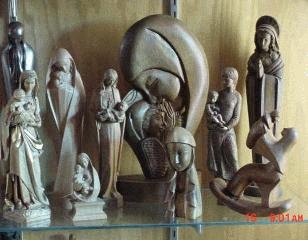The Pieta Statue
The Pieta

The Pieta Statue is located on Savidge Street at the front and East corner of the Church. It is an exact copy of Michelangelo’s Pieta and is dedicated to the memory of the deceased priests, parishioners, religious, and friends of St. Mary’s Parish. It is one of only three full-size copies and is made of fiberglass, weighing 700 pounds. Spring Lake was selected as the home for this highly acclaimed piece of art because the parish is dedicated to the Blessed Mother.
The Pieta by Michelangelo was commissioned by Cardinal Villiers Groslaye in 1498. It is one of the few marble sculptures with his signature “Buonarrotti” carved on the Blessed Mother’s ribbon.
For many years, the Holy Father received numerous requests from around the world for a public showing of the Pieta. As the World Fair of 1964-65 in New York approached, the idea arose of displaying the Pieta at the Vatican Pavilion. The Holy Father finally consented to removing the statue from Rome for the first time. The advantages of having this piece of art seen and appreciated by several million people who would never have the opportunity to see it in the original setting was overwhelming. Before permitting the statue to leave the country, several prominent artists were called in to study the possible means of producing an exact duplicate should some unknown or unanticipated disaster befall the original during its travel across the ocean.
The artists studied this intricate sculpture and decided that no one could again capture this masterpiece except by using modern technology and copying it. By using sophisticated and meticulous processes of lamination, they produced molds directly from the original marble. Their methods picked up every minute detail with the result that an “exact reproduction” was created. This reproduction was cast in modern materials because of its many advantages of tremendous strength and ability to withstand exposure to the elements.
In order to share this world-renowned work of art, permission was granted to re-cast additional figures using the same mold. The first and original casting is still at the Vatican. The second casting is in Iowa and the third is here in Spring Lake, Michigan. A fourth one (80% in size) is located in Denver, Colorado. We are proud to have this inspiring work here on permanent display, reminding all of the great suffering and sacrifice of both Christ and His Mother. The Italian word, “Pieta”, means “Sorrowful Mother” and truly this sculpture inspires us to take up our cross, as the Blessed Virgin did. This work beautifies our church grounds and helps promote devotion to God by the many who view it as they pass by each day.
Mosaic, Madonna’s, and Relics

A beautiful mosaic covers the entire wall behind the Altar. This mosaic depicts a “Triumphant Christ” standing in a large aureole with His hands outstretched, beckoning all to “Come Unto Me.” This glass tile mosaic is the work of well-known German artist, Herr Wilfried Braunmiller, and was imported from Munich, Germany. It was taken apart and shipped in sections, and then reassembled on the wall of the church, completed in 1967. On the left side of the work one will see the symbol of the suffering and on the right side, the symbol of the Redemption. The longer you look at the mosaic, the more you can see. The artist’s interpretation is: “On the left side is the symbol of the suffering; and the right, the symbol of Redemption.” All of the mosaics and works of copper and enamel are original works of art.
The wall on which the mosaic was attached required extensive repair and damage was discovered in the tile pieces in 2019. Marion Restoration, a firm out of Chicago that specializes in mosaics and other historical works of art, was commissioned to repair and restore the mosaic in 2020. Every individual tile was removed, cleaned, and repaired/replaced as necessary. A new mounting wall was constructed that will not permit moisture to damage the tiles any longer. The restoration work was completed just before Christmas 2020 and should allow the image to be viewed by worshippers for decades to come!

St. Mary’s is also the home of over 300 Madonna statues, housed in the Eucharistic Chapel, a small sanctuary off from the East side of the Altar. There are three specially designed showcases of statues which were left to the Parish by its late Pastor, Msgr. Kupinski.
Each statue is different- either in design, in the material from which it is made, or the land from which it came. They range from very small- two or three inches in height to nearly three feet. They are made of marble, plaster, metal, glass, quartz, lava, wood, porcelain, bisque and other materials.
There are black Madonnas, brown Madonnas, and white Madonnas. Parishioners and friends brought many of the statues to Msgr. Kupinski from their travels around the world, with some from Italy, Germany, the Netherlands, the Philippines, Mexico, Japan, Spain, Portugal, and Africa.
About Our Reliquary
Catholic tradition has honored relics–tiny pieces of the remains of saints–for many centuries. We recognize that our road to salvation was paved in part by the heroic sacrifices of those who went before us in the faith, sometimes offering their lives to ensure that the faith would be passed to future generations. Just as we respect the remains of our departed loved ones by burying or interring them in sacred places, we honor the remains of many saints by reposing them in sacred vessels called reliquaries. As we visit cemeteries and mausoleums to remember and honor our deceased family members, we visit reliquaries to pay homage to our brothers and sisters in the Communion of Saints.
Relics are not kept out of superstition, or the hope that they have some kind of magical powers. They are simply a way to honor the heroes of our faith. They remind us that these people were real, not fictional characters we read about, and they did so much for us.
St. Mary’s Church has a reliquary display inside the main church. It is East of the Altar on the outer wall of the Eucharistic Chapel. It houses relics from Elizabeth Ann Seton, Frances of Rome, Frances Xavier Cabrini, John Vianney, Justin de Jacobis, Maria Goretti, Peter the Apostle, Pope Pius X, Therese of Lisieux, Thomas Aquinas, as well as a piece of the true Cross of Christ. A booklet is available near the reliquary display which provides brief profiles of the saints whose relics we are blessed to have in our church.
